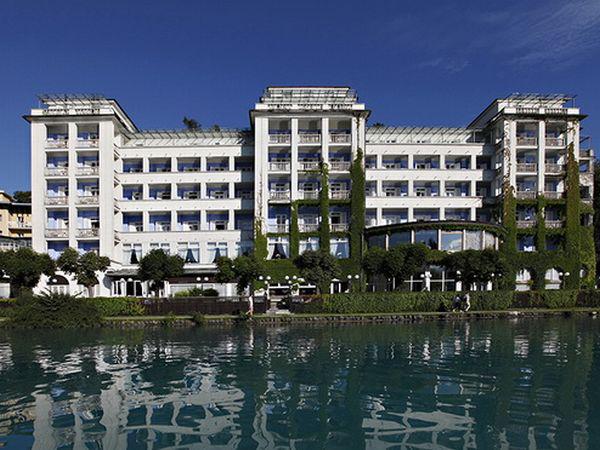
Even for the standards of Bled, Slovenia’s foremost mountain resort, the Grand Hotel Toplice is a special place. Through the years, it has hosted everyone from Paul McCartney and Pablo Neruda to Donald Trump and Monica Lewinsky.
The hotel’s long story has its origins in 1818, when two springs were discovered on the site of today’s hotel, on the shore of picturesque Lake Bled. The water wasn’t particularly hot, but it was a constant 23 degrees Celsius (73 degrees Fahrenheit) all year round, and a covered bath was soon built over the springs. By the second half of the 19th century, a hotel had emerged on the spot, and it soon began to attract discerning guests from across Europe to Bled, which was becoming an increasingly popular resort. Hotel Louisenbad, which changed hands several times before World War I, boasted a café, a post office, and even an “Oriental coffee house.”
But it was a Slovenian woman named Jula Vovk Molnar who made the hotel truly special. She bought the hotel at the close of the Great War, and had the original structure torn down. The new building, designed by an Austrian architect, made the hotel one of the finest in the country. Molnar renamed it the Grand Hotel Toplice (“toplice” being the Slovenian word for a hot spa).
It was during Molnar’s ownership of that Europe’s elite, including celebrities and prominent artists, regularly gathered at the hotel. Molnar was determined to make the hotel a world-class establishment and frequently visited Europe’s top resorts to learn from other hoteliers’ experiences.
Some of the most prominent guests were European diplomats. King Alexander of Yugoslavia had his summer residence in Bled, and the entire diplomatic corps would move from Belgrade to the resort for a few months every summer. Many ambassadors and their families stayed at the Grand Hotel Toplice.
Molnar, ever the entrepreneur, was determined to keep the hotel at the center of the action. She invited the Czechoslovak ice hockey team to play the nascent Yugoslav team on the frozen surface of Lake Bled. The event was a success, despite the 24:0 victory for Czechoslovakia. She also set up a golf course, one of Yugoslavia’s first.
With the outbreak of World War II, the days of glitz and glamour in Bled came to an end. The Grand Hotel Toplice became the headquarters of the Gestapo. After the war, wounded Partisans were housed on its premises.
The advent of Communism promised to change the fortunes of the Grand Hotel Toplice. Molnar was stripped of her ownership of the hotel in the second wave of nationalizations carried out in Yugoslavia. The hotel had become government property.
The Communist regime, however, knew the importance of the hotel for Slovenia’s tourism. The authorities decided to keep it a luxury hotel -- the flagship of Yugoslav tourism. They retained the tradition of its pre-war owner: the first Communist-era manager of the hotel was a former elevator operator whom Molnar had sent to be trained in London.
Even Molnar herself received special treatment. Unlike many other former business owners, who were completely dispossessed by the new regime, Molnar was given a villa by the lake in recognition for creating one of the country’s foremost hotels. Still, she was deprived of a source of income, and had to make dolls – wearing Slovenian national costumes -- to make ends meet.
In large part because of Molnar’s legacy, the hotel soon attracted increasing numbers of European guests, despite the tense, Cold War conditions. Because President Tito decided to continue King Alexander’s practice of spending the summer in Bled, the Grand Hotel Toplice once again housed foreign diplomats all summer long. One of them was the Czech Ambassador to Yugoslavia, Josef Korbel, who brought his young daughter Marie Jana Korbelová with him. Korbelová visited the hotel again many years later as Madeleine Albright, the U.S. Secretary of State.
Even though the hotel was now located in a Communist country, it continued to attract wealthy visitors from Western Europe. Some had stayed in the hotel before the war, while many others discovered Toplice anew on tours that took them from the Slovenian Alps to the Dalmatian coastline. In an age of austerity, the hotel offered a level of service on par with the best in Western Europe.
Since independence, the Grand Hotel Toplice has remained Bled’s flagship hotel and one of the leading tourist establishments in the country. Nowadays, it’s difficult to imagine Bled without its “grand old dame,” and it’s impossible to imagine the hotel without the spunk, vision and determination of Jula Molnar.

































































